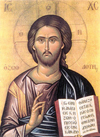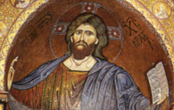

Revelation
The Christ


Who or What is The Christ?
C. S. Lewis: Revelation and the Christ, is a series of books about Jesus Christ.
Jesus of Nazareth, the Christ, is of central importance to humanity.
Jesus Christ is considered by orthodox Christians to be
the unique revelation of God, the God above all ‘gods’,
the God beyond all ‘gods’.


Lewis speaking in the wartime BBC radio broadcasts, the fourth series, Beyond Personality: the Christian Idea of God, 1944, p. 43
Who or What is The Christ?
Revelation
To assert that Jesus of Nazareth, the Christ, is of central importance to humanity, that he is the unique revelation of God, the God above all “gods,” the God beyond all “gods,” are strong, dynamic and assertive claims. There claims, these various ideas and interpretations of whom or what this Jesus of Nazareth, the Christ was and is, these theories vary across the churches. However, down the centuries there has been a constant and steady seam of knowledge and understanding as to who Jesus Christ is, how he is God, and how this affects all of humanity. To talk about Jesus Christ is to speak of revelation – God’s self-revelation, God’s revealedness to humanity. Therefore God initiates both in our knowledge and understanding about these most important of matters, but also, crucially, in our salvation.
Who or What is The Christ
Like many ancient names that had cultural or religious meanings, the name Jesus (in Hebrew, Yeshua given to Mary by Gabriel the Angel at the annunciation) was known to those who heard it as signifying “God is saviour,” or “Jehovah is saviour.” The word Christ means “anointed one,” “messiah.” The word Messiah was commonly used in the era between the two testaments, Old and New (i.e. the intertestamental period), the concept of messiahship having developed in later Judaism (from the early Hebrew Mashiach, the anointed one, derived from the ancient Hebrew tradition of anointing the King with oil). Messiah was not necessarily a name, but a label, an attribution, an office, a role, essentially a title. By the time of Jesus of Nazareth the title messiah was often attributed to someone the people liked, whom they believed could fulfil, they hoped, a role for them. However, amongst the Temple priests and Hebrew scribes and scholars, the Messiah was to be the one anointed at the End of Days. Jesus is therefore taken by those around him to be The Messiah; hence the early attribution that he is The Christ. The word Christ is simply a translation from the Greek (Christos) and the Latin (Christus) for messiah. Therefore Jesus Christ, in name and title, was God’s salvation, the anointed one. This did not necessarily imply that he was the second person of the Trinity. The Trinitarian perception is part of the dawning realization in the early Church, with ample pointers and examples of Jesus’s Trinitarian nature in the books that became the New Testament (passages produced by the early Church in the years after the resurrection and ascension).
Expectations
Around the time of Jesus’s birth messiahship carried expectations. Some saw the coming messiah as a political leader who would expel the Romans; others expected a messiah who would be a partisan revolutionary whose aims were unclear; to yet more the messiah would return the Temple religion back to a happier time, he would oversee the restoration of Israel. To an extent these can be seen as purely human, even secular political, offices. During the intertestamental period there were many false messiahs, men raised up to realize a revolutionary, political or religious role supported by a group or sect to save Israel in some way or other. However, false messiahs lapsed, disappeared, or were killed by the Romans or the Jewish religious authorities. The Jews were left still hoping.
Redemption
The idea of redemption, salvation, was part of these multitudinous expectations of a messiah figure during the intertestamental period: but saved from what, redeemed to what? The answer was as varied as the messianic expectations of these false messiahs. As a redeemer figure, expected and foretold, Jesus does not necessarily live up to the expectations of his fellow Jews. However, on reflection, the clues were there all along in Jesus’s life and ministry, and crucially in the Old Testament. The ancient Hebrew priests and kings were anointed, they were messiahs (Exodus 30:22-25); later, this messiahship entitled one anointed by God as a leader, a King from the line of David. Therefore Jesus of Nazareth was perceived by many who saw and heard him to be the long awaited messiah, with different and often subjective expectations as to his role. But this is more than just his role as an itinerant teacher, preacher, and healer. The manner of his torture, suffering, and death tied together predictions from the Old Testament (Isaiah 53, among others). Many realized this at the time as he hung on the Cross. Then came the resurrection, which drew together all of salvation history but left them puzzled, confused, and wondrous.
Trinitarian Revelation
What is important is that a posteriori, after the event, the proto early Church interpreted this messiahship in the context of Jesus’s role as God descended to earth to judge and forgive humanity, hence the use of the Greek word Christos, Christ, by the writers of the New Testament. Jesus is then the final messiah of messiahs.
Messiah, Christ, is then revealed to be Trinitarian: God anoints God to descend to save his chosen people, in potential, along with all humanity, reascending with them into the divine life. Only in the fullness of the incarnation-cross-resurrection and the ascension is messiahship finally defined by Jesus. Then his life and ministry, his sayings and actions, take on new meaning, a significance and understanding veiled to many, but not all, during his lifetime. Whatever the expectations of messiahship, Jesus of Nazareth is The Messiah (therefore, The Christ), not a messiah among many, political or otherwise, and certainly not yet another religious guru, shaman, teacher, among hundreds across the world’s religions. It is fair to say that some of the Hebrew expectations were blown away by God’s revelation; whatever people expected it fell short of what was given by God in this Jesus. People couldn’t see or fully understand what messiah was to be, even though the evidence was there in the Old Testament.
The Early Church and a Hebrew Tradition
The witness of the apostles, disciples and the early church is then a form of revelation considered equal to Scripture. The early Church tradition replaces the old Hebrew categories of messiahship; the expectations of Jesus’s contemporaries were fulfilled by God’s revelation, but not necessarily in accordance with what they desired or expected. This divergence also extended to the interpretation of messiahship the Jewish religious authorities held to in Jerusalem. For many years the Western Church concentrated only on the early Church tradition and the conclusions of the Church Councils in the fourth and fifth centuries, often, in effect, ignoring the Hebrew tradition that Jesus of Nazareth was born into. In recent years many theologians and Bible scholars, for example the orthodox Christian N.T. Wright, derive most of their conclusions about Jesus of Nazareth from an understanding of the New Testament’s Jewish background, a setting in the life of the times in some ways. Perhaps the answer is to hold in balance the Hebrew tradition and categories, also the early Church perception, but also the conclusions of the Church Councils, about the person and nature of Jesus. This is how to see and understand the term messiah, The Christ.
The Study of The Christ
C. S. Lewis: Revelation and the Christ, is a work, in many ways, of Christology; that is, the study of the work and person of Christ, Jesus of Nazareth. Christology is thinking about, explaining using the faculty of reason, mostly in written form, so as to explicate who and what Jesus Christ was and is. This is the branch of theology called Christology. Lewis’s work was very much in the context of the developed understanding of who and what Christ was in the first seven centuries of the Christian era; as with the Bible, this understanding became something of a compass as to what is sound doctrine about Christ and what is not. This body of understanding of what is a traditional and orthodox understanding of Jesus Christ developed gradually during the early Church, and then through the following centuries, and was complete by around the year 650 CE. Christology is therefore seen to be the study of the person and work of Christ, fully human and fully divine, historical and universal, and His significance for humanity: this systematic study is therefore the doctrine of Christ, but it must always understand the Hebrew roots into which Jesus of Nazareth was born and lived.
Lewis’s Christ
We can ask what do we make of Lewis’s understanding of Jesus Christ, the incarnation of the one true living God? How do we define/categorize Lewis’s objective understanding of Christ, and likewise his subjective appropriation? What Christological model does Lewis draw on? Lewis’s Christ, that is the picture he gives us in his Christology, is essentially a picture in words, a Christ from below, not primarily from above because it starts with Immanuel, God with us. This is balanced, initiated, by a shift from eternity into our reality: the Christ descends to raise us up; in doing so we are drawn into the divine life. However, humanity is not overwhelmed by Christ: Christ is the loving servant, but authoritative in His divine claim on all creation, a creation that, for Lewis, Christ sang into being, into existence, out of nothing. Lewis’s Christology is therefore high: this is God incarnate, not a wandering preacher/healer who was super-religious, or a Palestinian carpenter who was a good moral teacher.
The key to Lewis’s Christology is in the authority of Christ in majesty, in the Last Judgement. But this is also God descended to be the humble servant, though reigning in the future, on high. Lewis’s understanding of Christ is grounded in the pure transcendent action of the God of love. This can be seen in Lewis’s own personal relationship with God in Christ. For Lewis, the conscious start of this relationship is in his conversion, which was both emotional and reasoned. The reasoning was very much pressed on him by the Roman Catholic Oxford Professor of Anglo-Saxon, J.R.R. Tolkien in the truth of the Creed: the Holy Spirit of God in Christ, through Christ, pressed upon Lewis, possessed and converted him, which he then had to accept within the bounds of reasoned knowledge and understanding. We must also consider as part of this relationship his deeper conversion after the death of his wife, Joy Davidman, in 1960.
Therefore Lewis reads his Christology initially from below in the light of the evidence of the self-revelation of the one true living God in Jesus of Nazareth, The Christ: this is the ground, the reality behind his conversion experience and his assertive apologetics. This points repeatedly to Christ from above, the Universal Christ of the Trinity, uncreated, eternally begotten, with the Father, the universal light of the world that comes down to redeem in, as Lewis and Tolkien termed our world, the “shadowlands.” Reasoning comes after this has happened, after the event, but is revealed to a degree in our minds because God has put knowledge of this in our hearts and minds. Lewis’s understanding/knowledge is after the event, after the Incarnation, Cross and Resurrection reveals God drawing us all towards eternity from above. Therefore it is the potential salvation of all, subject to our appropriation of Christ’s atonement. Holiness, sanctification, for Lewis, is the key here, we are to be perfect – whatever it takes (those who reject this merely point to the reality of hell).
Lewis’s picture of Christ in his writings is not simply a restatement of orthodox, classic or high Christology in the form of apologetic writings and symbolic narratives; Lewis’s Christology is important in its vibrant balance between the humanity of Immanuel and the power and authority of the shift from the above, the timeless, to here below, into to the world of shadows. Lewis’s Christ is significant and important and has often been overlooked in the history of twentieth-century theology.
This material is a summary of parts of the introduction, and also some ideas dealt within chapters from C. S. Lewis: Revelation and The Christ.


Download this essay in PDF:
PDF : ‘Who Is The Christ?’
If citing this essay please use the following:
P.H. Brazier, ‘Who Is The Christ?’ www.cslewisandthechrist.net/the_christ.html.
and then give paragraph numbers and date accessed.

Home
Book One
Book Two
Book Three
Book Four
Links
Contact
“In the Highest Degree”







Author


